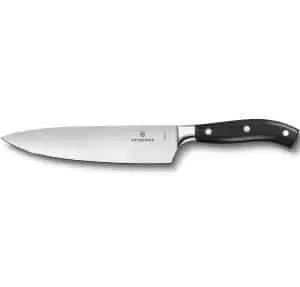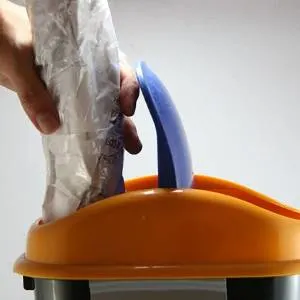
Knives are one of the most relied on and used tools in the kitchen. We use them to cut, chop, dice, and julienne vegetables, fruits, and herbs for cooking or garnishing meals.
They can also be used as a serving utensil by cutting pieces of bread or cheese at the table. But no matter how much we rely on our knives it is inevitable that they will eventually need some maintenance to keep them in working order.
This article will show you how to polish knife blade scratches so that you keep your knives in great condition.
Read More: Types of Kitchen Knives: 11 Varieties For Home Chefs
How To Remove Scratches From A Knife Blade
There are several ways to remove scratches from a knife blade, depending on the condition of the blade.
Buff and Polish the Blade
If the blade is only slightly scratched, you can use a buffing wheel and polishing compound to remove most of the scratches.
This method works best on blades that have just a few small scratches. If there are several deeper cuts or major damage to the metal then this may not be an option for you.
Steel Wool
If you have a blade with deep scratches, the buffing wheel will not be able to effectively remove them.
One option is to use steel wool instead of a wheel. This method works best on blades that are extremely dull or damaged but can also work on lightly scratched blades.
You will need several sheets which you should hold against the blade at about a 45-degree angle while you move it back and forth across the blade in small circles.
Sharpening Stone
Another method for polishing knife blade scratches is done with sharpening stones.
These are often used when attempting to sharpen the edge of a dulled knife, but they can also be used to buff out scratches in certain cases! This method works like the steel wool method in that you need to move the blade across the stone at a 45-degree angle and in small circles.
The biggest difference between this and the steel wool is that rather than holding large sheets of steel wool against the knife, you hold it in your hand.
This method will only work on those blades with deep scratches as well as those which are extremely dull or damaged. If your knife is just scratched but not very dull then one of the other 2 methods should work fine for you.
Rotary Sander
Another method involves using a rotary sander.
Carefully coat the sanding head with fine-grit sandpaper and hold the blade against it at about a 45-degree angle. You can experiment with speed, pressure, and angle until you are comfortable enough to do this on your own.
This method works best on blades that are severely damaged, deeply scratched, and very dull. It should not be used on lightly scratched blades.
Air Sander
The next method for polishing knife blade scratches is with an air sander.
This is a high-speed tool that uses compressed air to move an abrasive sanding pad over the surface of the metal. It can be used on blades that are severely damaged, deeply scratched, and very dull. It should not be used on lightly scratched blades.
Sand Paper
Finally, you can use sandpaper to remove scratches from a knife blade.
This method is commonly used on blades that have been seriously damaged or are extremely dulled. If the blade is only lightly scratched then this may not be an option for you.
Some people will opt to use it when polishing knife blade scratches because they feel that they have better control of the process and they feel it works more effectively than steel wool or sharpening stones do.
Again, just start by moving your knife across the sandpaper held at a 45-degree angle and in small circles over the surface of the blade until all of the major scratches have been buffed out.
Read More: What Is A Knife Bolster: Features And Benefits
Tips for Polishing Knife Blades
It’s a good idea to start with the least abrasive polishing method – buffing with a polishing compound – and then move on to the more abrasive methods if necessary.
Keep in mind that the steel wool and sandpaper methods involve using a rougher grit. This can wear down or damage your knife so if you are concerned about keeping your blades sharp then it may be best to use one of the other methods.
Be sure that you are using proper safety techniques any time you use power tools, especially something as powerful as an air sander. Before attempting this method be sure that you’re comfortable with it.
Also, keep in mind how you are holding the knife. If you hold it at an angle that is greater than 45 degrees then you could either accidentally cut yourself on the blade or decrease the effectiveness of these techniques.
If else fails, try taking the knife to a professional who will have the tools and experience to get the job done properly.
What if my Knife has a Special Coating?
If your knife has a special coating – like titanium or ceramic coating – then it’s best to take it to an expert to carry out maintenance or repairs.
These coatings are very delicate and can easily be damaged if you try to polish the scratches yourself.
If your knife blade has a textured or colored coating, then attempting to remove scratches will ultimately lead to you removing the coating. The only option, in this case, is to have the knife refinished.
Preventing Scratches on a Knife Blade
As with most things in life, it is easier to prevent scratches on a knife blade than it is to repair them. There are a number of things you can do to prevent your knife blade from becoming scratched.
Clean Your Knife Regularly
Dirty knives will be covered in all kinds of corrosive materials, from blood to chemicals. Make sure you clean your knife as soon as possible after use and dry it thoroughly before putting it away.
Wipe Clean with a Polishing Cloth
Use a polishing cloth to remove any debris that has built up on the blade after use. This is especially important if you have been cutting anything acidic or corrosive like oranges or lemons because these can also cause scratches on blades.
Store It Properly
When you’re not using your knife for any period of time make sure you put it back in its protective covering or sheath so that it doesn’t come into contact with other objects which might scratch it.
Read More: How To Sharpen A Serrated Knife: A Simple Guide
Alternatives to Knife Blade Scratch Removal
If your job requires that you have a knife that is in tip-top condition then you may not want to invest much time or effort into removing scratches from the blade. In this case, it’s best to simply get rid of the knife and get another one instead.
The cost of having these scratch removal techniques done professionally will be more than what you’ll pay for a new knife so this is usually the best option if you’re concerned with keeping your blades looking sharp.
How to Dispose of Knives Safely
 If you look after your knives and maintain them properly, they should last a long time. However, the time will come when you want to get rid of them. When you do, you’ll want to make sure that you are disposing of your knives responsibly and safely.
If you look after your knives and maintain them properly, they should last a long time. However, the time will come when you want to get rid of them. When you do, you’ll want to make sure that you are disposing of your knives responsibly and safely.
There are a number of things to consider when you’re thinking about how to go about doing this:
- Is there a recycling center in your area? If so, they can help ensure that your knives will be recycled properly rather than ending up as landfill waste.
- Check with local scout troops and boy/girl scout organizations as many of them accept old or broken tools for recycling purposes. They may also do fundraisers where they sell unwanted tools at affordable prices which could give you an opportunity to buy new knives without having to spend too much money.
- Check with local law enforcement agencies – especially the police department – to see if they have programs where you can turn knives in for proper disposal. The knives may be melted down and used for other purposes or simply disposed of properly without posing any sort of hazard.
- If you are going to dispose of your knives in the trash, be sure to wrap them in cardboard and ensure the blades are sealed. This reduces the chance of accidental injury to waste workers.
Whatever method you choose when disposing of old knives, it’s important that you do this responsibly because there may be penalties associated with improperly disposing of them. The last thing you want is your old knives ending up in the wrong hands.
How To Polish Knife Blade Scratches – Final Thoughts
I hope this article has been helpful in showing you how to polish knife blade scratches. It is important to keep our knives in good condition so that we can rely on them for all of our cooking needs.
There are a number of methods you can use, depending on the severity of the scratches and how much time and effort you want to put into it.
Remember that prevention is always better than cure so make sure you clean your knives regularly and store them properly to avoid having to remove any scratches later on.
Read More: 15 Essential Vegan Kitchen Tools
